One of the more difficult things to stockpile is any sort of fuel. That’s primarily because by definition anything we use as a fuel, is flammable. Therefore, there is always risk in storing it; a risk that is directly proportional to how flammable the fuel itself is. On top of that issue, not all fuels store well, losing their potency over time.
Nevertheless, people have stored some fuels for centuries and even the fossil fuels we are so dependent on for more than 100 years. So it is clear that we can store fuel; we just need to figure out how to store it safely.
Part of that is knowing where to store it; part is coming up with the right containers; and part is doing whatever else is necessary to keep that particular fuel in a usable condition. This obviously varies from one fuel to the next.
As preppers, the two fuels we are most interested in are wood and gasoline. But those aren’t the only fuels we might find ourselves using. Other petroleum-based fuels, like kerosene and lamp oil are extremely useful too, especially in a post-disaster scenario where the electrical grid is down.
While it might prove to be impossible to store enough fuel to see us through the next decade, it is clearly possible to store enough to help us through a post-disaster time, especially if we use it sparingly. The right precautions and the right preparation are all it takes.
Related: Best Fuels For Off-Grid Survival
Wood
Of the various fuels we’re talking about, wood is probably the safest to store, as it is considerably less volatile than gasoline. We can stockpile wood and keep it for years, without anything serious happening to it. But we still need to take precautions.
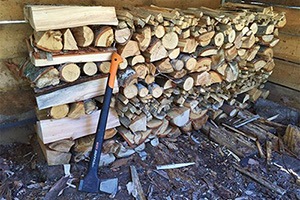 The first thing is that we don’t want to store that wood up against our homes. While people have built woodpiles up next to their homes, where the eaves could help keep moisture off the wood, it creates a fire hazard. It also provides termites a clear path into the home, where they can do structural damage. The risk just isn’t worth it.
The first thing is that we don’t want to store that wood up against our homes. While people have built woodpiles up next to their homes, where the eaves could help keep moisture off the wood, it creates a fire hazard. It also provides termites a clear path into the home, where they can do structural damage. The risk just isn’t worth it.
Yet that wood needs some sort of protection from the rain, otherwise, every time it rains, the exposed end grain of the wood will soak up water. That will make it extremely hard to use the wood for the fire. So, you should either keep the wood in a shed or rig a tarp over it, to protect it from the rain.
However, that wood pile should be kept off the ground, so as to keep termites and other insects from getting into it.
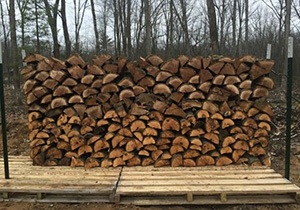
That can be accomplished by creating an area of sand and putting the wood pile on it or by using pressure-treated wood to build a wood rack. Termites won’t eat pressure-treated wood, so a wood rack made of it is an effective barrier against termites.
Related: How to Store and Stack Firewood The Right Way
Gasoline
Gasoline is the hardest fuel to store for a prolonged period of time. It’s highly volatile, so it ignites easily. But the volatility causes another problem, as the components of the gasoline which evaporate first are the most flammable ones. This is why people say that gasoline can’t be stored for more than six months, unless a fuel-stabilizer is used. Even then, the stabilizer makes it only good for about 12 months.
But the US military shipped gasoline to forces in the field, in five-gallon cans and 55-gallon drums, throughout the Second World War and the Korean War. How could they do what people today say can’t be done?
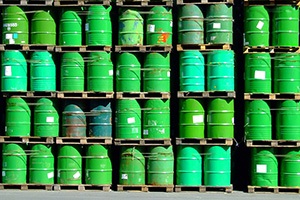
First of all, the military only shipped gasoline in sealed metal cans; not in plastic gas cans. Not even in Jerry cans, which have a rubber gasket seal.
The seal used was a metal one, which was impermeable to the gasoline vapors, even in a hot climate.
The same thing will work for us, if we store gasoline in sealed 55 gallon drums or metal cans with a metal seal.
This shouldn’t be done in the home or even up close to the home, due to the flammability of the gasoline. Fortunately, the autoiginition temperature of gasoline is 536-853°F. So it’s not going to simply light itself on fire, if we leave a drum sitting outside on a hot day.
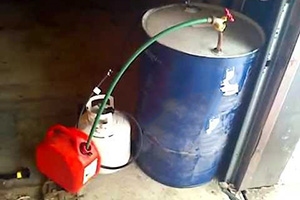 I have kept a 55-gallon drum of gasoline in my garden shed for years. The shed sits in the shade of a large tree. Even though I live in a hot climate, it never seems to get above 120°F in there, no matter how hot it is outside. The steel drum is laying on its side, on a stand, with a brass spigot installed in the smaller bung hole.
I have kept a 55-gallon drum of gasoline in my garden shed for years. The shed sits in the shade of a large tree. Even though I live in a hot climate, it never seems to get above 120°F in there, no matter how hot it is outside. The steel drum is laying on its side, on a stand, with a brass spigot installed in the smaller bung hole.
The larger bung hole is up, allowing me to use it to fill the drum. Since the drum is sealed, the flammable elements don’t easily evaporate.
Related: 7 Survival Uses for Expired Gas
Nevertheless, in order to keep that gasoline fresh, I rotate my stock. As part of that, I regularly use the gas to power my lawnmower, rototiller, chain saw and a generator I use. I also pull a can or two a month out and put it in my car. Then I go to the gas station and buy gas to fill the drum back up, always maintaining it full.
Being full also helps reduce the amount of evaporation. In this way, I’m always sure that the gasoline I’m storing in that drum is good gasoline.
If you don’t have a shed to store your gas drum in, I’d recommend at least keeping it in the shade. You also want to keep it hidden from view, as neighbors might see that as a cheap way to fill their tank.
Never try storing gasoline for more than a day or two in plastic gas cans. While they are safe for transporting gas, the gas and vapors inside will expand on a hot day, putting a strain on the plastic. Eventually it will start to leak. Since plastics are petroleum products, the gasoline can soak into the plastic as well, evaporating slowly through it.
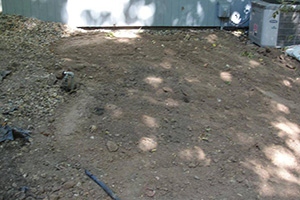 Another option is to bury a drum in the ground, with the head of the drum at ground level. This will work to keep the fuel cool, while also keeping it out of sight.
Another option is to bury a drum in the ground, with the head of the drum at ground level. This will work to keep the fuel cool, while also keeping it out of sight.
However, there is a very real danger that the barrel will rust through, spilling the gas and allowing water into it.
So, if you’re going to do this, first cover the barrel with several heavy coats of paint. Even then, I’d recommend replacing it every couple of years.
Related: The First Thing You Need To Do When The Gas Price Rises Above $5 Per Gallon
Other Petroleum Products
Kerosene and lamp oil are useful in a survival situation as well. Like gasoline, you’re best storing them in metal containers, even though they both come in plastic ones. Neither evaporates as readily as gasoline, and lamp oil evaporates slower than kerosene does. Nevertheless, both can evaporate, especially when stored for a prolonged period of time.
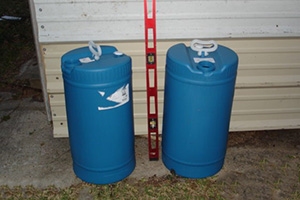 If you’re planning on using kerosene for heating, you’ll need a lot of it, so 55 gallon metal drums make sense for storing it as well. You can store it with the drums vertically or horizontally, just like gasoline.
If you’re planning on using kerosene for heating, you’ll need a lot of it, so 55 gallon metal drums make sense for storing it as well. You can store it with the drums vertically or horizontally, just like gasoline.
But like gasoline, I’d recommend keeping it in a hidden place to keep it from being stolen.
Someone might even think it’s gasoline and try running it in their car, which would be tragic for them, and tragic for you, as you’d lose however much kerosene they took.
Another way of storing these flammable liquid fuels is in a flammable materials cabinet. These are required in industry, although you don’t have to have one at home. Besides being painted yellow, flammable materials cabinet is metal and has a door that closes automatically, whenever it isn’t being held open. The combination keeps sparks from getting to the flammable liquids inside.
A fair approximation of a flammable materials cabinet can be improvised by using a truck toolbox.
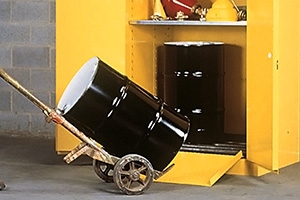
I have a small one in my workshop, that used to be mounted in the back of a truck I had. It’s not a full-width box, but rather, one that bolted to the floor.
It will hold about six one-gallon containers, and has a lid that I’ve modified so that it will fall shut, whenever I let go.
That way, when I take something out, it closes automatically.
While I don’t use it for lamp oil, kerosene or gasoline, but rather flammable solvents. It’s an effective flammable materials cabinet. I weld and grind in that workshop too and the toolbox keeps the sparks away from those solvents (that’s why they are in there).
Related: How To Make Survival Lamps With Used Cooking Oil and Mason Jars
Vigilance Is Important
Regardless of how you store any fuel, don’t just leave it and ignore it.
It’s necessary to inspect your fuel stocks on a regular basis. Try looking for any signs of deterioration of either the fuel itself or what’s protecting it. Most problems with fuel can be recognized early, before anything serious goes wrong.
You may also like:
g 26 Necessary Tools for Off-Grid Living
26 Necessary Tools for Off-Grid Living
The Pocket Soup that Saved the Lewis and Clark Expedition (Video)
9 Places Where You Can Find Energy After An EMP
How to Make Firebricks (fire logs) and Wood Stove Logs for Free!






















Very good info. You better make sure that you take precautions for this products. It can become a bomb. That’s not good for you or your family. If you decide to store this. Last thing you need in a SHTF is to get burned or blown up because of neglect.
Trust me I blew a house up while I was in it. Yes was burned very badly. It was propane. Just as bad as the rest of the flammable products that we use for our survival..
This is one of the most scariest thing you will need to prep. so please be careful. Last thing any of us want to hear is one of our prepper family’s getting hurt.
Please becarful. I went thru 6 month of some of the most pain any one would ever want to go thru. The pain was beyond your wildest imagination. Burns so deep that even my veins were burned. The skin was hanging off of me in sheets and I look like a bloody and burnt body. I still to this day get upset to even think about it. My house was saved well some of it.
I’m telling y’all this so you will know this shit will burn or even kill you. So please Becareful.
Stay safe at any thing you do to try and survive.
So a thick plastic 55 gallon drum would not be the best thing to store gas in, because i have 3 clean one’s on hand?
It’s highly recommended that when storing volatile liquids in a metal cabinet, that the cabinet be grounded to earth, especially in arid environments. When I was in the military, we had to make sure to check the grounding points on all the chem cabinets.
No those are great for water or they may be used for cooking oil I’m guessing on the oil. But for sure you can store water in them.
How about diesel, my jeep is diesel, also my tractor, diesel is not as ignitable as gasoline
Why don’t you talk about propane?
What do you want to know. ?
Is there anything special for propane that you need to do?
Store it under a covered area and keep it clean and take good care of it during the time you are storeing it.
That’s what I do. Keep out of the direct sun. Cool area.
Easier to keep then gasoline. Last a lot lot longer. Keep off the dirt…
Make sure the propane tank is well painted. Condensation will form on the tank as the day warms up and the cold propane in the tank makes water drops form on the metal and run down the tank. Even in a shed, even under cover.
Mark: That is true also for fuel oil: i used to have my fuel company put a can of “heat” in my oil tank for my furnace every other fill up to help prevent the condensation buildup.
If you store gasoline for any period of time, months even, you should add some type of stabilizer, Sta-Bil for example, there are several others, and always use ethanol free gasoline. The ethanol absorbs water and also causes other problems over time. If you store kerosene, you need to add an antibacterial agent since it will eventually acquire bacteria. Most companies, government agencies, public utilities, etc. that have backup generators with large diesel storage tanks almost always contract with a company who comes every so many months and add these additives. Very inexpensive but very effective maintenance measures. We store gasoline, kerosene, and diesel for a year or more and no problems. Generator, lawn mower, blowers, trimmers, boat motors, etc., start and run year after year.
Find a gas station that sells non ethanol gas. It lasts a lot longer.
Make sure the propane tank is well painted. Condensation will form on the tank as the day warms up and the cold propane in the tank makes water drops form on the metal and run down the tank. Even in a shed, even under cover.
Our suppliers require every tank be painted white. A few suppliers allow silver but make sure you check with your supplier. We had our two tanks painted a very light tan to match the house but they made us repaint it.
Upstate NY Mike – Very few of them down state. Diesel best way to go around here.
Some folks out here in the country have their propane tank installed underground. Pricey, but very secure.
Propane is not more dangerous than natural gas, but it’s not unusual for country folk to do their own plumbing, and for it to leak. That idiot that blew himself up in Nashville turned his camper into a fuel/air bomb by opening up some propane tanks and igniting when the mix was just right. Blew up half a block of Nville’s tourist district (no casualties), an improvement I think.
If you have propane you need propane and CO detectors, smoke detectors, O2 sensors are good also. All this safety stuff is cheap and easy to install.
The primary danger with Propane is that it is heavier than air. It will flow downhill and pool. So, yes, it IS more dangerous than Natural Gas. On the plus side, due to its nature, it is always sold, stored and shipped in approved containers.
Good things to considder
i had the same thought – i guess because like the smaller 5 gal plastic pails eventually it goes through
All alcohol absorbs water, both ethanol and isopropanol. In an interesting juxtaposition, we used it in the water fountain to lessen surface tension and make the printing plate more receptive to water and at the same time, in the delivery tray the IPA in the water fountain hastened ink drying as it evaporated more quickly than water, hastening ink drying so that the printed matter could be folded, stapled, spindled or whatever more quickly.
IPA’s hydrophilic property is why you can’t buy 100% IPA in the regular marketplace. 100% IPA only comes from special plants in a sealed can. To remain a true 100% IPA it has to be opened in a controlled environment much like a clean room. If a can is marked 100% IPA and you can afford it, it is fake, especially if it is not in a sealed container. A screw cap doesn’t do it. We bought 99% IPA to use in our pressroom. It was nominally 100% but in order to avoid unnecessary litigation in litigious PDRK, it was labeled 99%.
Plastics are permeable. Microscopically they have a rough porous surface. They absorb material from substances placed inside them. For a concrete example, I have a one-gallon Tree-Top apple juice plastic jug. It is several years old. It has been filled with distilled water every other week for some years now, at least 10. If I have my nose close to the lid, when I open the empty container I can still smell apple juice. The plastic jug also has a very slight brown tint to it from the apple juice. You can only see it if the light is just right, but it definitely is there. It’s okay for bringing home distilled water from the water store to use in my coffee maker and for drinking, but certainly is not suitable for long term storage of drinking water. For that I used glass, gallon wine jugs. I have mentioned before, A gallon of cheap wine in a glass wine jug is cheaper than buying an empty glass gallon jug. It is $2.00 and change cheaper. So even if you throw out the wine it is cheaper to buy wine in jugs than empty jugs.
That is why it is best not to use plastic jugs for long term storage of potable products. There are special plastic jugs which are considerably more expensive than an apple juice container that are designed for long term water storage and they have never held any other product except the water you put in them.
I would suggest perusing the U-Line catalog for plastic containers. They have one of the most extensive lines of plastic containers for long term storage and for medical use of any website of which I am aware.
I believe you can also find fuel containers that are designed for long term storage in the U-line catalog but I am not absolutely certain about that. Perhaps if U-line doesn’t have it, it doesn’t exist.
The $40 plastic gas cans at WallyWold(that used to be $10.00) are not designed for long term storage. They are designed for walking to the gas station with the empty can and walking back with a full can. Or filled up on Friday afternoon and used up in the generator over the weekend to be almost empty on Sunday night when packing up. You will lose content and the content that is lost is the most volatile in the container. That’s what gets your engine going.
When I first report to the 1st Marine Air Wing for duty, for some reason known only to the personnel department, I was assigned to MABS 11. Marine Air Base Squadron 11’s primary duty was acting as the utility company for the Wing. They didn’t have court-martial jurisdiction and didn’t know what to do with a court reporter suddenly in their midst. So, I was assigned as a personal secretary to a Marine captain who was writing a report on fuel loss in the field during a recent maneuver in the Philippine Islands.
I am happy that I got that temporary assignment because I learned a tremendous amount about fuel and fuel storage preparing the report for its submission to Marine Headquarters in D.C. You would be absolutely amazed at how rapidly gasoline evaporates in high temperatures.
At that time aviation gasoline in the field was stored in 500 gallon butyl rubber bladders that were supposed to be evaporation proof. Well, I guess the chemists were wrong about butyl rubber being evaporation-proof.
The problem was ameliorated by the MABS buying rice straw from the Philippinos — “Hey, the crazy Americanos are buying rice straw. Can you believe it? And they are paying way too much for it too.” — and covering the bladders (which were, of course, black, so they would reflect the sun’s rays — not) with wet rice straw to act as a cooling agent. If my 60+ year old memory still serves me, that cut the gasoline loss from 25% (I was astounded that that much gas evaporated out of a closed container. That’s why I remember that figure after all these years) down to abut 12%. Still a significant figure but a considerable savings in fuel loss.
Now your 85% gasoline isn’t as volatile as 120 octane aviation gasoline, but the alcohol in it makes up for the lesser octane and it will evaporate in high temps even through “evaporation proof” containers unless they are tightly sealed metal.
Granted plastics have come along way since “The Graduate” and since MarEx57 in the Philippines, but the problems of porosity still exist.
For those of you not old enough to have seen “The Graduate” the 1967 motion picture staring Dustin Hoffman, I believe his first starring role, the secret to investment was one word “plastics.”
I owned a pre-press business for over a decade before selling it to a customer. We made litho plates and letterpress and foil-stamping dies in Kansas City. Fun to hear to talk about IPA in fountain solution. I now work for a major wood preservative company. I enjoy your insights on this site. Keep it up friend.
JBW: Were you a subcontractor to Hallmark?
Thanks for the kind comments. I try to make them cogent and informative although don’t always hit a home run. I console myself with “Neither did Babe Ruth hit a home run every time at bat. He struck out more times than he hit a homer.”
Fuel will last a while, but not very long. We live miles from other towns, but are on a gas line. In the event of shtf, they’ll reverse the gas to draw it back to the city. Water, thank God, is local and the company is rewiring to have all solar pumps.
My father-in-law had a fuel tank buried in his yard in the 70’s. When my wife was driving a car of her own, she learned how to pick the lock and steal gas. He thought he’d sprung a leak and capped it, and ended up passing away without ever knowing the truth of the matter.
To my knowledge, it is still there and full of gas. 😮
With our recent third-world style power outage here in SoCal this week, I broke out some of those little green bottles that one can use to fire up Coleman lanterns or stoves that use such.
They had been in the storage shed in a wooden box for well over 22 years. It may even have been closer to 30 or 40 years that they have been sitting in the shed because my recollection of recent uses of Coleman equipment have been the little one burner white gas stove and not the two-burner propane stove. One bottle was empty. ,he plastic cap was missing from it, so I don’t know if it was a partial bottle that got put away hoping it wouldn’t leak to empty or if it was a new bottle with a defective seal. Two others of the three I took out were full and the stove works great. Heats twelve ounces of coffee almost as fast as the microwave.
I was quite pleased that the stove still worked after all this time. There was a little corrosion that didn’t interfere with the operation of the stove. It looks almost new. I have had that stove since my kids were quite small. Considering that my son is retiring from a major airline this month and my daughter is going to retire in June, I have had that stove a good many years.
What about barrels that have the metal ring locking lid? Can I use those? Thanks